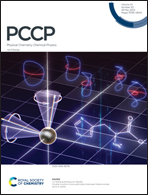Half-metallic and magnetic semiconductor behavior in CdO monolayer induced by acceptor impurities†
Abstract
In this work, a doping approach is explored as a possible method to induce novel features in the CdO monolayer for spintronic applications. Monolayer CdO is a two-dimensional (2D) non-magnetic semiconductor material with a band gap of 0.82 eV. In monolayer CdO, a single Cd vacancy leads to magnetization of the monolayer with a total magnetic moment of −2μB, whereas its non-magnetic nature is preserved upon creating a single O vacancy. Doping the Cd sublattice with Cu–Ag and Au induces half-metallic character with a total magnetic moment of −1 and 1μB, respectively. Dopants and their neighboring O atoms produce mainly magnetic properties. By contrast, doping with N, P, and As at the O sublattice leads to the emergence of magnetic semiconductor behavior with a total magnetic moment of 1μB. Herein, magnetism originates mainly from the spin-asymmetric charge distribution in the outermost orbitals of the dopants. Bader charge analysis and charge density difference calculations indicate charge transfer from Cu, Ag and Au dopants to the host monolayer, whereas the N, P and As dopants exhibit important charge gains. These results suggest that doping with acceptor impurities is an efficient approach to functionalize the CdO monolayer to generate spin currents in spintronic devices.



 Please wait while we load your content...
Please wait while we load your content...